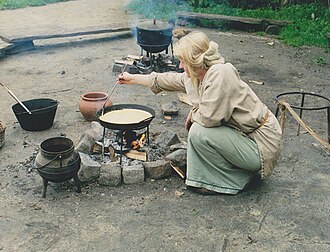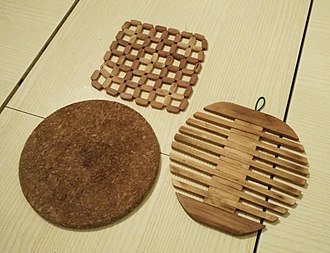Trivet
A stand or support used in cooking and serving
A trivet is a small stand or support used to hold a cooking vessel above the heat of a stove or fireplace, or to protect a table or countertop from a hot pot or dish. Trivets can be made from a variety of materials, including metal, wood, ceramic, and silicone. They are an essential tool in both kitchens and dining areas, serving both practical and decorative purposes.
History[edit]
The use of trivets dates back to ancient times, with early examples found in archaeological sites. In the Iron Age, trivets were often made of iron and used to support cooking pots over open fires. These early trivets were simple in design but highly functional.

During the Middle Ages, trivets became more ornate, reflecting the craftsmanship of the period. By the Victorian era, trivets were often elaborately designed and made from cast iron, featuring intricate patterns and designs.
Types of Trivets[edit]
Trivets come in various forms, each suited to different purposes:
Metal Trivets[edit]
Metal trivets, often made from cast iron or stainless steel, are durable and can withstand high temperatures. They are commonly used in kitchens to support heavy pots and pans.

Wooden Trivets[edit]
Wooden trivets are popular for their aesthetic appeal and are often used on dining tables to protect surfaces from hot serving dishes. They are typically made from hardwoods like oak or maple.
Ceramic and Stone Trivets[edit]
Ceramic and stone trivets are valued for their heat resistance and decorative qualities. They often feature colorful glazes or intricate designs, making them a popular choice for both functional and decorative use.
Silicone Trivets[edit]
Silicone trivets are flexible, heat-resistant, and easy to clean. They are often used in modern kitchens for their practicality and versatility.
Uses[edit]
Trivets serve multiple purposes in both cooking and serving:
- Cooking: In the kitchen, trivets are used to elevate pots and pans above the heat source, allowing for even cooking and preventing scorching.
- Serving: On the dining table, trivets protect surfaces from heat damage and can also serve as decorative elements.
- Decorative: Many trivets are designed with aesthetics in mind, adding a touch of style to kitchen and dining areas.
Cultural Significance[edit]
In some cultures, trivets hold cultural significance and are used in traditional cooking methods. For example, in Middle Eastern cuisine, trivets are used to support large pots for communal meals.

Modern Innovations[edit]
Modern trivets have evolved to include features such as adjustable sizes, foldable designs, and non-slip surfaces. These innovations make them more versatile and user-friendly.

Related Pages[edit]

Gallery[edit]
-
Maurice Ascalon, Pal-Bell Trivets
Ad. Transform your life with W8MD's Budget GLP-1 injections from $75


W8MD offers a medical weight loss program to lose weight in Philadelphia. Our physician-supervised medical weight loss provides:
- Weight loss injections in NYC (generic and brand names):
- Zepbound / Mounjaro, Wegovy / Ozempic, Saxenda
- Most insurances accepted or discounted self-pay rates. We will obtain insurance prior authorizations if needed.
- Generic GLP1 weight loss injections from $75 for the starting dose.
- Also offer prescription weight loss medications including Phentermine, Qsymia, Diethylpropion, Contrave etc.
NYC weight loss doctor appointmentsNYC weight loss doctor appointments
Start your NYC weight loss journey today at our NYC medical weight loss and Philadelphia medical weight loss clinics.
- Call 718-946-5500 to lose weight in NYC or for medical weight loss in Philadelphia 215-676-2334.
- Tags:NYC medical weight loss, Philadelphia lose weight Zepbound NYC, Budget GLP1 weight loss injections, Wegovy Philadelphia, Wegovy NYC, Philadelphia medical weight loss, Brookly weight loss and Wegovy NYC
|
WikiMD's Wellness Encyclopedia |
| Let Food Be Thy Medicine Medicine Thy Food - Hippocrates |
Medical Disclaimer: WikiMD is not a substitute for professional medical advice. The information on WikiMD is provided as an information resource only, may be incorrect, outdated or misleading, and is not to be used or relied on for any diagnostic or treatment purposes. Please consult your health care provider before making any healthcare decisions or for guidance about a specific medical condition. WikiMD expressly disclaims responsibility, and shall have no liability, for any damages, loss, injury, or liability whatsoever suffered as a result of your reliance on the information contained in this site. By visiting this site you agree to the foregoing terms and conditions, which may from time to time be changed or supplemented by WikiMD. If you do not agree to the foregoing terms and conditions, you should not enter or use this site. See full disclaimer.
Credits:Most images are courtesy of Wikimedia commons, and templates, categories Wikipedia, licensed under CC BY SA or similar.
Translate this page: - East Asian
中文,
日本,
한국어,
South Asian
हिन्दी,
தமிழ்,
తెలుగు,
Urdu,
ಕನ್ನಡ,
Southeast Asian
Indonesian,
Vietnamese,
Thai,
မြန်မာဘာသာ,
বাংলা
European
español,
Deutsch,
français,
Greek,
português do Brasil,
polski,
română,
русский,
Nederlands,
norsk,
svenska,
suomi,
Italian
Middle Eastern & African
عربى,
Turkish,
Persian,
Hebrew,
Afrikaans,
isiZulu,
Kiswahili,
Other
Bulgarian,
Hungarian,
Czech,
Swedish,
മലയാളം,
मराठी,
ਪੰਜਾਬੀ,
ગુજરાતી,
Portuguese,
Ukrainian